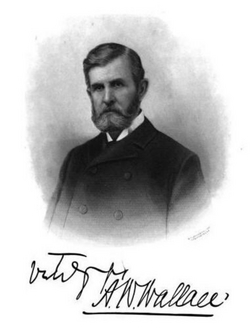
Wallace was one of four sons of John Wallace who fought in the Civil War. He ended the war as a corporal with Company C, 30th Virginia. The war interrupted his legal career which was resumed and he was licensed to practice law in 1866. Wallace tended to stay with the institutions he served both in his legal career and that with the church
In 1889 he was elected by the State Legislature to a six-year term as judge on the Corporation Court of Fredericksburg. He was twice re-elected. He retired to continue his stint on the Board of Visitors of UVA. He also served as president of the National Bank of Fredericksburg from 1909 after the death of his nephew and served for 10 years before passing it off to another nephew.
We remember Wallace at St. George’s in two areas:
He served the second-longest term on the St. George’s vestry, first from Dec. 3, 1881- April 18, 1881, and then from March 26, 1883, to Dec. 31, 1922. The total years was 42, half of his 84 years. He was also a trustee of St. George’s beginning in 1902. He served St. George’s both at the Diocese level and General Convention.
Secondly, he was extremely generous to the church. A. Wellington Wallace left $6,100 to the Benevolent Society for the “benefit of needy, poor widows of the city of Fredericksburg over fifty years of age, in the months of December, January, February, and March for their imminent need each year.” This became a separate fund in his name with $5,000 invested in bonds. Towards the end of his life in 1926, he donated $500 to the church debt retirement fund which was matched by the Vestry members at the time.
His wife Victoria Stevens Wallace (1859-1927) acted as a philanthropist throughout her life. She was originally from Philadelphia and retained significant investments there that did well. At her death in 1927, her estate was valued at $500,000 with $60,000 of Philadelphia real estate going to the Diocese of Virginia and the Female Charity School in Fredericksburg whose income at the time went to children in need of help for their education. She donated 12 stained glass windows to the Church in 1908 and 1909.
In October 1931 the nieces and nephews of Judge and Mrs. Wallace gave the Church a Holy Table as a memorial to their uncle and aunt.
Wallace also was a gifted writer. According to John Goolwrick in Historic Fredericksburg: The Story of an Old Town, Wallace wrote a book on the “intents, purposes and meaning of the constitution.” This included an analysis of the intent of the authors.
Wallace’s portrait still hangs in the Fredericksburg courtroom, a painting completed in 1902 by Willis Pepoon and presented to the Court in 1935.